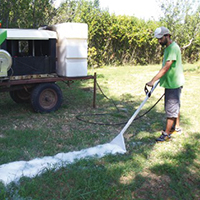Hot foam and hot water for weed control: A comparison

Published:30 September 2021
Abstract Views: 2480
PDF: 783
HTML: 81
HTML: 81
Publisher's note
All claims expressed in this article are solely those of the authors and do not necessarily represent those of their affiliated organizations, or those of the publisher, the editors and the reviewers. Any product that may be evaluated in this article or claim that may be made by its manufacturer is not guaranteed or endorsed by the publisher.
All claims expressed in this article are solely those of the authors and do not necessarily represent those of their affiliated organizations, or those of the publisher, the editors and the reviewers. Any product that may be evaluated in this article or claim that may be made by its manufacturer is not guaranteed or endorsed by the publisher.
Similar Articles
- Andrea Peruzzi, Luisa Martelloni, Christian Frasconi, Marco Fontanelli, Michel Pirchio, Michele Raffaelli, Machines for non-chemical intra-row weed control in narrow and wide-row crops: a review , Journal of Agricultural Engineering: Vol. 48 No. 2 (2017)
- Xiwang Du, Xia Li, Fangtao Duan, Jiawei Hua, Mengchao Hu, Static laser weeding system based on improved YOLOv8 and image fusion , Journal of Agricultural Engineering: Vol. 55 No. 4 (2024)
- Daniele Torreggiani, Alberto Barbaresi, Francesca Dallacasa, Patrizia Tassinari, Effects of different architectural solutions on the thermal behaviour in an unconditioned rural building. The case of an Italian winery , Journal of Agricultural Engineering: Vol. 49 No. 1 (2018)
- Yerong Sun, Kechuan Yi, Agricultural machinery photoelectric automatic navigation control system based on back propagation neural network , Journal of Agricultural Engineering: Vol. 54 No. 4 (2023)
- Wei Deng, Chunjiang Zhao, Liping Chen, Xiu Wang, Constant pressure control for variable-rate spray using closed-loop proportion integration differentiation regulation , Journal of Agricultural Engineering: Vol. 47 No. 3 (2016)
- José Roberto Moreira Ribeiro Gonçalves, Gabriel Araújo e Silva Ferraz, Étore Francisco Reynaldo, Diego Bedin Marin, Patrícia Ferreira Ponciano Ferraz, Manuel Pérez-Ruiz, Giuseppe Rossi, Marco Vieri, Daniele Sarri, Comparative analysis of soil-sampling methods used in precision agriculture , Journal of Agricultural Engineering: Vol. 52 No. 1 (2021)
- Chiara Cevoli, Angelo Fabbri, Simone Virginio Marai, Enrico Ferrari, Adriano Guarnieri, Estimation of thermal conductivity of short pastry biscuit at different baking stages , Journal of Agricultural Engineering: Vol. 45 No. 2 (2014)
- Juan Ãngel Mintegui Aguirre, José Carlos Robredo Sánchez, Carlos de Gonzalo Aranoa, Pablo Huelin Rueda, Jorge Fallas, Felipe Cisneros, Pedro Cisneros, Adriana Urciuolo, Rodolfo Iturraspe, Forest use strategies in watershed management and restoration: application to three small mountain watersheds in Latin America , Journal of Agricultural Engineering: Vol. 45 No. 1 (2014)
- Maria Elena Menconi, Massimo Chiappini, Jan L.M. Hensen, David Grohmann, Thermal comfort optimisation of vernacular rural buildings: passive solutions to retrofit a typical farmhouse in central Italy , Journal of Agricultural Engineering: Vol. 48 No. 3 (2017)
- Roy Latsch, Joachim Sauter, Optimisation of hot-water application technology for the control of broad-leaved dock (Rumex obtusifolius) , Journal of Agricultural Engineering: Vol. 45 No. 4 (2014)
You may also start an advanced similarity search for this article.

 https://doi.org/10.4081/jae.2021.1167
https://doi.org/10.4081/jae.2021.1167 











